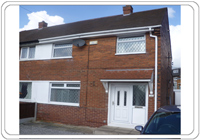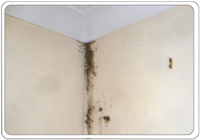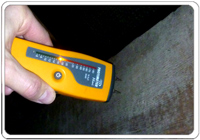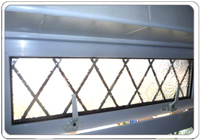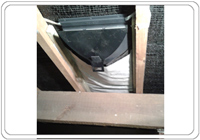
Case study: A semi-detached house in Wakefield with mould and poor air quality
The problem
This house was occupied by a family of four and had poor air quality problems and quite severe mould in the master bedroom. To make matters worse one of the family members was recovering from a severe respiratory illness. Because of this we made every effort to compile our report quickly and, when our quote was accepted we installed the systems shortly afterwards.
Our assessment
On the face of it this is a very normal property but as is so often the case changes had been made to the house over the years that had the effect of gradually sealing up the property and so making air quality steadily worse. When a home reaches a 'tipping point' the levels of humidity are high enough to support the growth of mould which in turn release a large number spores into the air. For occupants with respiratory problems this is far from the ideal environment.
There were a number of factors in this house which either limited the flow of air or increased the humidity:
- The roof underlay was the type typical for a house of this age, a black hessian non-breathable felt
- The soffits have a PVCu covering without ventilation holes.. Not allowed under regulations for newly built houses - and with good reason.
- The windows were modern PVCu draughts proof units without vents
- The bathroom fan was cheap and ineffective.
- There were four occupants in the house.
Where a loft is poorly ventilated it almost always has an effect on the air quality in the rest of the house. It also means that the roof timbers themselves become damp - which ultimately leads to the risk of rot or damage from wood boring insects.
Our solution
It is essential that the loft is adequately ventilated and there are several ways of doing this. We recommended the fitting of internal roof vents,. These are fitted from the inside without any changes to the external roof covering, Fitting them in pairs encourages a flow of air across the loft space.
Now that the ventilation problem in loft had been dealt with we installed a loft positive input ventilation (PIV) system to bring a controlled flow of air from the loft into the house.
In addition to the PIV system we installed window trickle vents to all the upstairs windows. These augment the PIV system and allow an imperceptible background movement of air through the bedrooms and bathroom. This brings down humidity levels in the problem rooms making the house feel much fresher and killing mould growth.
We were unable to replace the ineffective bathroom fan because of the configuration of the walls and ceiling however we were satisfied that the changes we made were more than sufficient to vastly improve the air quality in the house and stop all mould growth.
See our page on solutions for condensation problems for further information.
High humidity + inadequate ventilation
= damp, condensation, mould

UK government advises:

